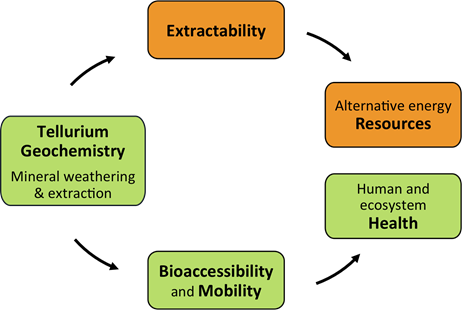
High technology’s dependence on critical elements, such as tellurium, has sparked uncertainty regarding future supplies and hampered development emerging high technology industries. Less discussed are environmental and health implications of extraction, geographic redistribution and device disposal of such elements. Tellurium (~3 mg kg-1 average crustal abundance) is enriched in Au-Ag telluride deposits, but exclusively extracted as a byproduct of copper mining. Accurate quantification, maximization of Te resources, and responsible environmental practices relies on an improved understanding of Te geochemistry in the ore-forming environment, deportment during extraction processes, and behavior in surficial environments.
We are examining Te speciation in ores, extraction processes, and in behavior in oxic weathering environments. The distribution of Te between telluride mineral inclusions and substitution in sulfides has important implications for hypogene Te geochemistry and ore formation based exploration models and optimizing extraction efficiency. Coupling mineralogical studies with mass balance calculations can optimize extraction processes. In collaboration with the only domestic Te producer, we have determined the overall Te recovery is ~2% of Te in the ore. Further, several inefficient processes and Te-enriched waste products have been targeted additional study with the goal of improving extraction efficiency. The fate of Te in historic mine tailings is also being examined as potential Te resources and to assess the associated health risks. Published thermodynamic datasets predict a variety of dominant species, some of which can be more toxic than Se and As. Preliminary data from semi-arid environments indicate the accumulation of less toxic TeVI in surficial layers of tailings, often associated with iron (oxy)hyrdoxides and sometimes as small particles (>5 um) that may be readily transported by wind or surface water.
These ongoing studies represent an important first step in assessing the potential for increased use of Te in high technology applications and the associated environmental impacts of industrial geographic concentration and redistribution of Te.